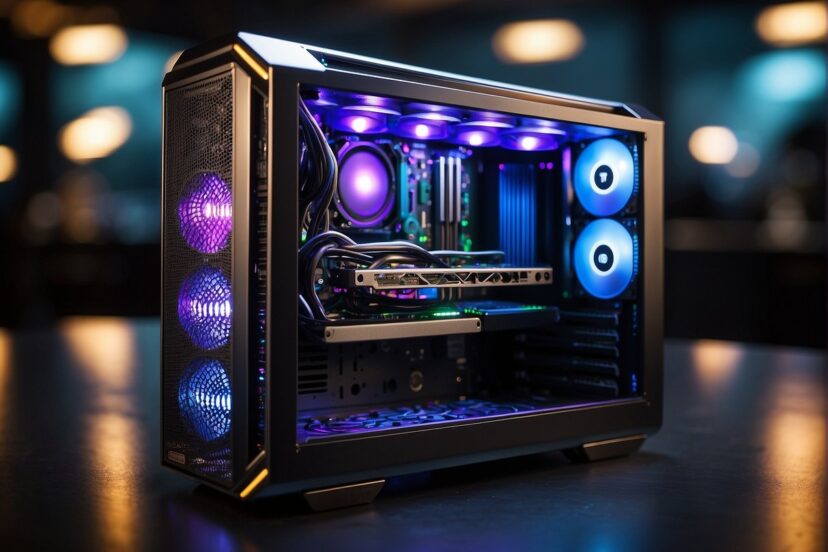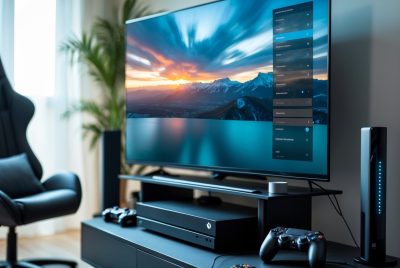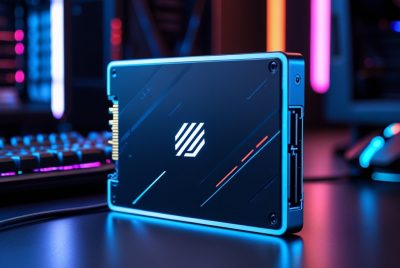PC Gaming Cases: Selecting the Best for Your Build
*We may earn a commission for purchases made using our links. Please see our disclosure to learn more.
PC Gaming Cases: Selecting the Best for Your Build
In the world of PC gaming cases, it is about more than just aesthetics; it’s about finding the perfect balance between form and function for your gaming rig. As someone who keeps up-to-date with the latest developments in PC hardware, I understand that the case is the foundation of your setup. It not only houses all critical components but also influences cooling efficiency, noise level, and expandability. The market offers a variety of cases that cater to different preferences whether you prioritize size, budget, or specific features.

Finding the optimal case means considering several factors. You’ll need to decide on the size—full-tower cases offer ample space for upgrades and airflow but take up more room, while mid-tower cases strike a middle ground and are a common choice for many gamers. Mini-ITX cases cater to those who want a compact system. Budget is another consideration; there is a range of cases available that meet various financial constraints without compromising on quality. For the build enthusiast, there are cases designed with transparent panels to showcase the internal components, often paired with RGB lighting to accentuate the build.
My experience tells me that the functionalities of a case extend beyond the surface. Gamers who crave silence can opt for cases engineered for noise reduction. Similarly, those looking for sophisticated designs can explore premium cases that blend elegance with robust build quality. With the wealth of choices at hand, I can confidently say that whether it’s for a visually stunning showpiece or a high-performance gaming behemoth, there’s a case out there that fits every gamer’s needs.
Fundamentals of PC Cases

Exploring the fundamentals of PC cases helps in understanding their impact on performance, usability, and aesthetics. I will address the importance of form factors, explain why airflow is crucial, and discuss design aesthetics.
Understanding Form Factors
When selecting a PC case, I consider the form factor crucial since it determines the size and compatibility with the motherboard. The primary form factors are:
- ATX: The standard size that offers balance and expansion options.
- E-ATX: Larger than ATX, designed for high-end systems with more space.
- MicroATX: Smaller with fewer slots but still compatible with ATX cases.
- Mini-ITX: The smallest mainstream form factor, ideal for compact builds.
Each form factor supports corresponding motherboards—ITX cases for mini-ITX motherboards, mid-towers for ATX and MicroATX, and some tower cases even accommodating E-ATX boards.
Importance of Airflow
Airflow within computer cases is pivotal for maintaining low temperatures and preventing heat build-up which could impede performance. Consider the following when assessing airflow:
- Ventilation: Sufficiently large and well-placed vents are essential for effective intake and exhaust.
- Heat: Components emit heat during operation, requiring efficient dispersal.
- Quality of life: Good airflow contributes to lower fan speeds, reducing noise levels.
Quality cases are designed with optimized airflow paths, offering various mounting points for fans or liquid cooling radiators, conducive to a cool and quiet computer case.
Design Aesthetics
Design aesthetics of a PC case can reflect personal style while housing the system’s components. A well-designed case includes:
- Materials: High-quality materials, such as thick steel or tempered glass.
- Finish: Attention to detail in paint finish or material polish.
- Extras: Aesthetic enhancements like RGB lighting or unique architectural features.
While aesthetics don’t directly influence performance, a visually pleasing case can enhance the overall experience and satisfaction with your build.
Choosing the Right Case

When I build or upgrade a gaming PC, the case is a crucial component. It’s not just about aesthetics; it’s about compatibility, dimensions, and investing in a chassis that aligns with my specific needs and budget.
Size and Compatibility Considerations
Choosing a case starts with size and compatibility. I must ensure the case is compatible with the motherboard size, whether it’s ATX, Micro-ATX, or another form factor. Clearance is also vital for components like GPUs and CPU coolers.
- ATX Case: Standard for most builds, offers space for upgrades.
- Micro-ATX: More compact, suitable for smaller workspaces.
Budget-Friendly Options
Budget is always a concern, but I’ve found that there are excellent budget-friendly ATX gaming cases that don’t compromise on quality. A good case doesn’t have to break the bank and still supports a solid gaming rig.
- Best Budget ATX Gaming Case: A balance between cost and functionality.
- Alternative Budget-friendly Picks: Other worthy options providing value for money.
High-End Cases for Enthusiasts
For my high-end builds, I prefer cases that offer premium features like robust build quality, exceptional cooling, and aesthetic appeal. The best PC cases for enthusiasts often include advanced features like RGB lighting and superior airflow designs.
- Premium RGB ATX Gaming Case: Ideal for showcasing my build.
- Features like tempered glass panels and expandability options distinguish a high-end case.
Enhancing Performance with PC Gaming Cases

When building a gaming PC, optimizing performance through proper case features is crucial. I’ll discuss how cooling, cable management, and support for future upgrades can significantly boost system efficiency.
Cooling and Airflow Optimization with PC Gaming Cases
In my experience, adequate cooling is essential for maintaining high performance. A case that supports various cooling options, including room for 360mm radiators, is ideal for keeping your CPU and GPU temperatures in check. Here’s what to focus on:
- Airflow: Ample airflow is facilitated by cases designed with strategically placed venting and fan mounts. Look for cases with pre-installed fans or those that offer multiple fan control options to enhance cooling.
- Radiator Support: I advise selecting a case with sufficient space for large radiators – at least 360mm – especially if water cooling is part of your build for silent yet effective heat dissipation.
Cable Management Solutions
Tidy cable management goes beyond aesthetics; it contributes significantly to airflow and, consequently, component performance. Features I look for include:
- Velcro straps or tie points: These simple solutions help organize cables neatly.
- Dedicated routing channels: Cases with these channels can prevent cable clutter, allowing for unobstructed air circulation.
Upgrade Potential
A good case can future-proof your build. Compatibility with a range of component sizes gives me the flexibility to upgrade my graphics card or CPU cooling system without changing the entire case. Points to consider are:
- Expandability: I prefer a case with ample room for additional fans, USB-C ports, and drive bays for extra storage.
- Modularity: The option to reconfigure internal layouts means I can customize component placements to suit new upgrades or cooling requirements.
By prioritizing these aspects, the gaming rig remains efficient and adaptable to evolving technology.
Technological Features and Connectivity
When I choose a PC case for gaming, I pay close attention to how its technological features and connectivity options will accommodate my hardware requirements. These aspects determine not only the performance but also the user experience and functionality of the gaming setup.

Motherboard and Port Options within PC Gaming Cases
Motherboard Support: My gaming case must support a range of motherboard sizes, from Mini-ITX to E-ATX, providing versatility for different builds. For instance, the Corsair Obsidian 1000D is accommodating, with support up to the larger SSI-EEB form factor.
| Motherboard Size | Support Status |
| Mini-ITX | Supported |
| MicroATX | Supported |
| ATX | Supported |
| E-ATX | Supported |
| SSI-EEB | Supported (Obsidian) |
I/O Ports: For I/O connectivity, I ensure there are enough USB ports, including USB 3.0 or even USB-C for faster data transfer, and audio jacks for easy access. These ports are usually found on the top or the front panel of the case for convenience.
- I/O Front Panel Connectors:
- USB Ports: Minimum 2x USB 3.0
- Audio Jacks: Standard 3.5mm Headphone and Microphone
Expansion and Mounting
Drive Bays: My case should have a combination of 2.5″ and 3.5″ drive bays to house my SSDs and HDDs, ensuring I have ample storage options. Some cases offer tool-less mounting, which I appreciate for easier installation and upgrades.
- Drive Bay Configuration:
- 2.5″ SSD Bays: At least 2
- 3.5″ HDD Bays: 1 or more
Tempered Glass and RGB Lighting: I pay attention to cases with tempered glass panels, not just for their elegant looks but for their sturdiness as well. When combined with RGB lighting, the case can display vibrant colors, which can be controlled and synced with my gaming rig.
Vertical GPU Mount: The option for a vertical GPU mount is something I consider for the aesthetic appeal and potentially improved airflow, understanding that it’s not just a visual feature but one that can influence cooling performance.
Notable Mounting Features:
- Option for vertical GPU mounts
- Tempered glass panels enhance aesthetics
- RGB lighting for customizable visual effects
By evaluating these features, I can select a gaming PC case that delivers a balance of form, functionality, and flexibility fitting my technological needs.
Noteworthy Models and Brands for PC Gaming Cases

In this section, I’ll guide you through standout models and brands in the realm of gaming computer cases, focusing on their design evolution and offering curated recommendations.
Iconic Designs and Their Evolution
Corsair Obsidian 1000D: When it comes to monumental designs, the Corsair Obsidian 1000D is a behemoth that’s evolved to cater to both enthusiasts and system builders. Its massive structure is not just about appearance but also about functionality, supporting elaborate cooling and storage setups.
Be quiet! Dark Base Pro 900: The Dark Base Pro 900 from Be Quiet! has made a name for itself with its modular design and exceptional noise damping features. Over time, this case has adapted to better suit high-end builds with an emphasis on silent operation.
Case Reviews and Recommendations
NZXT H710i: This is a mid-tower case that integrates modern features with an eye on aesthetics. Its evolution includes improvements in cable management and the inclusion of a smart device that can control fans and Razer Chroma lighting.
Fractal Design Meshify 2: Known for its distinctive angular mesh design that boosts airflow design, Fractal Design’s Meshify 2 has become a favorite among system builders. The case balances a bold look with the practicality needed for optimal thermal performance.
NZXT H7 Flow: The H7 Flow by NZXT is another notable mention, specifically designed to maximize airflow, which is crucial for maintaining system stability during intense gaming sessions.
Tom’s Hardware mentions and reviews often highlight the importance of airflow design, and the cases I’ve recommended here align with their insights into what makes a gaming computer case stand out for both functionality and form.
Frequently Asked Questions
In this section, I’ll address some of the most common inquiries to guide you through the process of choosing and understanding the importance of a good PC gaming case for your setup.
1. How do I choose the best PC gaming case for my setup?
When selecting a gaming case, I consider factors like the size and compatibility with my components, the case’s airflow design, and its expansion capabilities. I also look for a case that balances aesthetics with functionality to match my personal preferences.
2. What are the advantages of a full tower PC case over other sizes?
A full tower PC case offers more room for high-end components, better airflow, and easier cable management. It’s also typically more future-proof, allowing for greater expansion and customization as I upgrade my PC gaming setup.
3. Which features should I look for when selecting a PC gaming case?
I prioritize features such as efficient cooling solutions with adequate fan mounts, dust filters, and spacious interior for component installation. USB ports and tool-less design are also important for convenient access and easy maintenance.
4. How does case size impact the performance and cooling of a gaming PC?
The case size affects airflow and the number of components I can install. Larger cases often support better cooling options and multiple graphics cards or storage drives, leading to improved performance and lower system temperatures during intense gaming sessions.
5. Why is the choice of a gaming PC case important for overall system performance?
The right gaming PC case is crucial for protecting components, ensuring adequate cooling, and reducing noise levels. A well-chosen case can significantly influence the reliability and longevity of my gaming system.




